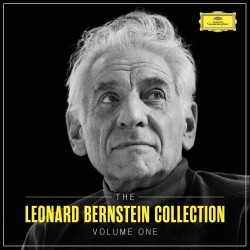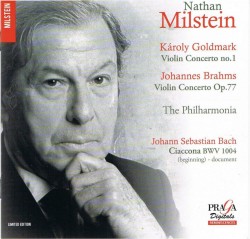Old Wine, New Bottles | Fine Old Recordings Re-Released - May 2014
Leonard Bernstein had a long career as conductor, composer, pianist, lecturer and educator. We witnessed his growth in every aspect through his recordings, from 78s to CDs and SACDs and visually from Beta to VHS tapes to DVDs. The recordings began in 1945 when RCA Victor initiated a series of American music played and conducted by Bernstein. In 1953 American Decca issued performances of popular symphonies accompanied Bernstein’s spoken analysis and then came the steady procession of his seemingly boundless repertoire recorded by Columbia mostly with his own New York Philharmonic but also with the London Symphony and the Israel Philharmonic.
He made his television debut on November 14, 1954 on CBS’ Omnibus with an analysis of the first movement of Beethoven’s Fifth Symphony with a grand copy of the first page from the score painted on the floor. The orchestra, members of Toscanini’s then recently dissolved NBC Symphony, played discarded passages from Beethoven’s workbook. Fascinating, yes, but there were only six more of Bernstein’s inspired creations, passed between CBS and NBC and finishing at ABC in 1958.
He expended a lot of time and energy on and took much pride in his memorable Young People’s Concerts that ran on CBS-TV from 1958 to 1972-73 with such subjects as “What does music mean?” “What is a Concerto?” “Humour in Music” and “Berlioz Takes a Trip.”
In 1957 he was appointed music director of the New York Philharmonic and in 1958 began his tenure that lasted until 1969 when he resigned, declaring that it took up too much time and that he would never again take on the role of music director of any orchestra. He continued to conduct them from time to time and make further recordings. He was named conductor laureate.
In 1972 DG recorded the Met production of Bizet’s Carmen with Marilyn Horne and James McCracken. It was Bernstein’s first recording for DG and by the way, it won a Grammy. Off to a good start. From then on he recorded mainly for DG, occasionally returning to Sony and on one or two occasions appeared on Decca, EMI or Philips. DG was there for his final concert in Tanglewood on August 19, 1990 when he conducted Britten’s Four Sea Interludes and the Beethoven Seventh with the Boston Symphony Orchestra. He died on October 14 and New Yorkers lined the streets of Manhattan for the funeral procession and construction workers were seen to remove their hats and call “Goodbye, Lennie.”
 The Bernstein Collection Volume One (Deutsche Grammophon 479 1047) contains all his audio recordings for DG by composers A to L. There are 59 CDs and one DVD, packaged in a sturdy LP sized box, two and a half inches deep. Each disc is individually sleeved in a replica of the original art work but without the liner notes on the back; they would have been too small to read anyhow. Instead there are track listings with timings and recording session data.
The Bernstein Collection Volume One (Deutsche Grammophon 479 1047) contains all his audio recordings for DG by composers A to L. There are 59 CDs and one DVD, packaged in a sturdy LP sized box, two and a half inches deep. Each disc is individually sleeved in a replica of the original art work but without the liner notes on the back; they would have been too small to read anyhow. Instead there are track listings with timings and recording session data.
Bernstein had made studio recordings of all the Beethoven symphonies with the New York Philharmonic (NYP) for Sony in the early 60s but there is no question that the sweep and continuity of the live versions with the Vienna Philharmonic (VPO) outclass them in every way for many reasons. The orchestra has a signature sound that is passed on from player to player, from one generation to the next. The sonority of their string sound is nurtured and protected. The aura of their winds, particularly the oboe is specific to the VPO. The burnished brass is legendary. Also Bernstein had certainly matured considerably as a conductor and a musician regardless of where he conducted. The differences are unmistakable interpretively and most certainly in the quality and reality of the recorded sound. These evaluations apply equally to the four Brahms symphonies. The DG years documented Bernstein’s finest music making both at home and abroad.
Although there is no mention of any new remastering, the sound on every disc that I played is disarmingly real. I went straight to disc 58 to hear a recording of a longtime favourite that I knew so well, Liszt’s Faust Symphony, the one with the Boston Symphony. I don’t recall the sound being so compelling and real. It made me very happy to be in Symphony Hall where it was recorded.
There’s lots of Bernstein conducting Bernstein, Copland, Ives and Harris, Haydn and Hindemith and the Carmen mentioned above, plus an interesting DVD of the making of West Side Story with Te Kanawa, Carreras et al. Check the complete contents of this Limited Edition set on the DG website, deutschegrammophon.com/us/. The Omnibus programs and The Young People’s Concerts are available on two DVD sets from kultur.com.
 In July 1957 EMI recorded Nathan Milstein playing the Goldmark Violin Concerto No.1 with the Philharmonia Orchestra conducted by Harry Blech. Milstein championed this ravishing concerto when it was virtually unknown. This stereo recording was reissued in 1995 by Testament in a faultless and satisfying transfer (SBT1047). The reel-to-reel stereo tapes from those sessions have passed into the hands of Praga Digitals who have prepared an SACD version coupled with the Brahms Violin Concerto conducted by Anatole Fistoulari (Praga PRD/DSD 350105). The DSD remastering of the original tapes has produced ambient recordings of unsurpassed reality, as clear and present as one could wish.
In July 1957 EMI recorded Nathan Milstein playing the Goldmark Violin Concerto No.1 with the Philharmonia Orchestra conducted by Harry Blech. Milstein championed this ravishing concerto when it was virtually unknown. This stereo recording was reissued in 1995 by Testament in a faultless and satisfying transfer (SBT1047). The reel-to-reel stereo tapes from those sessions have passed into the hands of Praga Digitals who have prepared an SACD version coupled with the Brahms Violin Concerto conducted by Anatole Fistoulari (Praga PRD/DSD 350105). The DSD remastering of the original tapes has produced ambient recordings of unsurpassed reality, as clear and present as one could wish.


